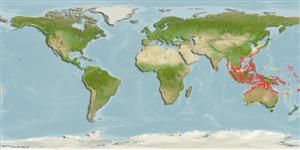>
Ovalentaria/misc (Various families in series Ovalentaria) >
Pomacentridae (Damselfishes) > Pomacentrinae
Etymology: Pomacentrus: Greek, poma, -atos = cover, operculum + Greek, kentron = sting (Ref. 45335).
Eponymy: Annie Montague Alexander (1867–1950) was an American philanthropist and fossil collector who established the fossil collection at the University of California Museum of Paleontology, Museum of Vertebrate Zoology and sponsored collecting expeditions. [...] (Ref. 128868), visit book page.
More on authors: Evermann & Seale.
Environment: milieu / climate zone / profondeur / distribution range
Écologie
marin récifal; non migrateur; profondeur 5 - 60 m (Ref. 7247). Tropical
Western Pacific: Indo-Malayan Archipelago east to the Moluccas and Mentawai Islands, north to Taiwan and the Ryukyu Islands.
Taille / Poids / Âge
Maturité: Lm ? range ? - ? cm
Max length : 9.0 cm TL mâle / non sexé; (Ref. 9710)
Description synthétique
Clés d'identification | Morphologie | Morphométrie
Épines dorsales (Total) : 13; Rayons mous dorsaux (Total) : 14 - 15; Épines anales: 2; Rayons mous anaux: 14 - 15.
Body shape (shape guide): short and / or deep; Cross section: compressed.
Adults occur in lagoon, inshore, and offshore reefs (Ref. 9710). Usually seen solitary, often swimming well above substrate (Ref. 48636). Feed on algae, barnacle nauplii, copepods, fish eggs, and small gastropods. Oviparous, distinct pairing during breeding (Ref. 205). Eggs are demersal and adhere to the substrate (Ref. 205). Males guard and aerate the eggs (Ref. 205).
Life cycle and mating behavior
Maturité | Reproduction | Frai | Œufs | Fécondité | Larves
Oviparous, distinct pairing during breeding (Ref. 205). Eggs are demersal and adhere to the substrate (Ref. 205). Males guard and aerate the eggs (Ref. 205).
Allen, G.R., 1991. Damselfishes of the world. Mergus Publishers, Melle, Germany. 271 p. (Ref. 7247)
Statut dans la liste rouge de l'IUCN (Ref. 130435: Version 2025-1)
Menace pour l'homme
Harmless
Utilisations par l'homme
Outils
Articles particuliers
Télécharger en XML
Sources Internet
Estimates based on models
Preferred temperature (Réf.
123201): 25.6 - 29, mean 28 °C (based on 634 cells).
Phylogenetic diversity index (Réf.
82804): PD
50 = 0.5000 [Uniqueness, from 0.5 = low to 2.0 = high].
Bayesian length-weight: a=0.02455 (0.01299 - 0.04638), b=3.00 (2.84 - 3.16), in cm total length, based on LWR estimates for this species & Genus-body shape (Ref.
93245).
Niveau trophique (Réf.
69278): 3.1 ±0.36 se; based on food items.
Résilience (Réf.
120179): Haut, temps minimum de doublement de population inférieur à 15 mois (Preliminary K or Fecundity.).
Fishing Vulnerability (Ref.
59153): Low vulnerability (10 of 100).
🛈
Nutrients (Ref.
124155): Calcium = 120 [59, 184] mg/100g; Iron = 0.789 [0.472, 1.299] mg/100g; Protein = 18.3 [17.1, 19.4] %; Omega3 = 0.133 [0.079, 0.219] g/100g; Selenium = 27.6 [14.8, 51.1] μg/100g; VitaminA = 95.9 [27.5, 319.9] μg/100g; Zinc = 1.71 [1.15, 2.45] mg/100g (wet weight);
